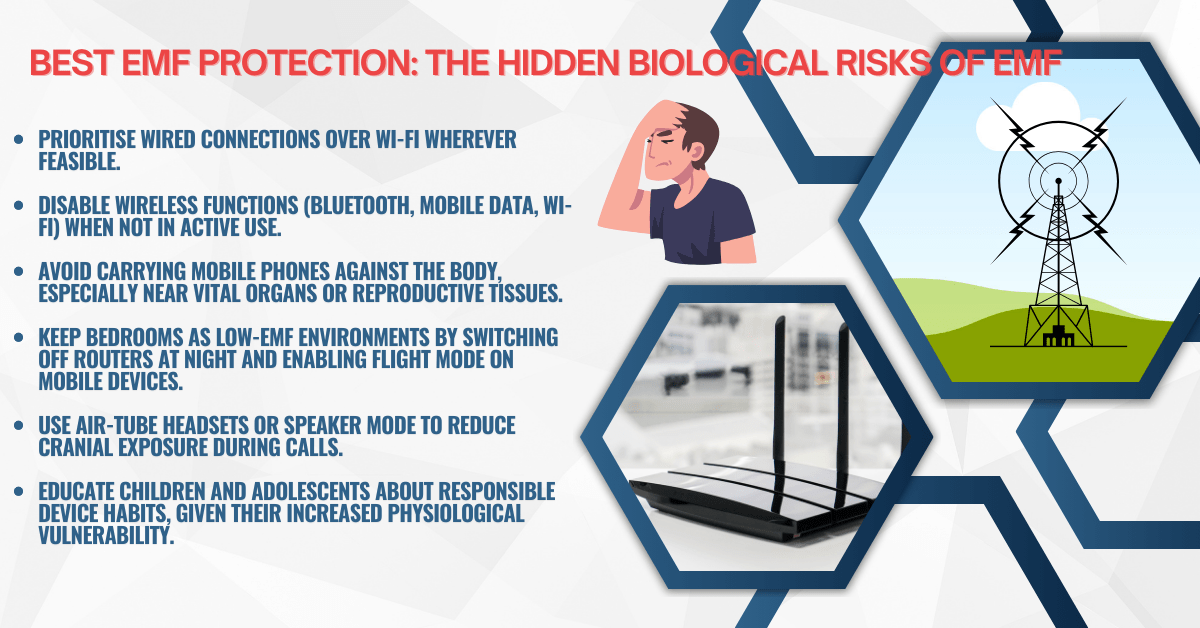
Best EMF protection is becoming an increasingly urgent consideration in the age of digital saturation, where every square metre of our environment is permeated by electromagnetic flux. An unsettling question looms with increasing urgency: are the very frequencies that connect our devices covertly unravelling our biology? As more individuals seek the best EMF protection to shield themselves from this pervasive exposure, a parallel body of scientific literature is quietly revealing a more disquieting truth. While industry narratives downplay potential risks, the scientific counterpoint – often marginalised – paints a deeply disquieting picture. Electromagnetic fields (EMFs), omnipresent and ostensibly innocuous, may in fact be triggering profound physiological and neurological perturbations that remain largely invisible, yet biologically consequential.
This investigation endeavours to chart the lesser-known, yet critically relevant, landscape of EMF-induced health effects – drawing from a growing body of empirical data that challenges conventional assumptions about electromagnetic safety thresholds. As exposure to electromagnetic fields intensifies in our daily environment, an urgent public dialogue is emerging around health risks — and the best EMF protection available to mitigate them.
EMFs Demystified: Understanding the Spectrum and Best EMF Protection Principles
The electromagnetic spectrum encompasses a vast array of frequencies, from static fields to gamma radiation. Most everyday technologies fall within the non-ionising portion – frequencies that, unlike X-rays or radioactive emissions, do not ostensibly carry enough energy to sever molecular bonds or directly ionise atoms.
However, the binary narrative of ionising equals dangerous, non-ionising equals safe is increasingly being dismantled. Non-ionising EMFs, particularly those in the extremely low frequency (ELF) and radiofrequency (RF) ranges, have been shown to elicit significant biological effects – not via thermal mechanisms, but through subtle interference with cellular signalling, membrane potentials, and oxidative equilibrium.
Neurological Vulnerability: EMFs, Brain Health, and the Need for Best EMF Protection
The human brain, operating through an exquisitely tuned symphony of electrical impulses and neurochemical exchanges, is arguably the organ most susceptible to disruption by extraneous electromagnetic influences.
1. Breaching the Blood-Brain Barrier
In a landmark series of experiments, Dr Leif Salford and colleagues demonstrated that exposure to mobile phone-level RF radiation compromised the integrity of the blood-brain barrier (BBB) in rats (Salford et al., 2003). This barrier, a selective endothelial interface, protects cerebral tissue from systemic toxins and pathogens. Its disruption allows plasma proteins and neurotoxic agents to infiltrate the brain parenchyma – a pathological vector strongly associated with neurodegenerative disorders and cognitive decline.
2. Impaired Neural Performance in Adolescents
Adolescents, whose neural substrates are still undergoing critical myelination and synaptic pruning, are particularly vulnerable. A longitudinal study by Foerster et al. (2015) revealed that higher RF-EMF brain dose from mobile device use was inversely correlated with figural memory scores – a finding with sobering implications for a generation raised in digital proximity.
3. Circadian Desynchronisation via Melatonin Suppression
Electromagnetic radiation, particularly when experienced nocturnally, has been shown to suppress pineal melatonin synthesis – the hormone responsible for regulating circadian rhythm and acting as a neuroprotective antioxidant. Burch et al. (1999) documented significant melatonin metabolite reduction in electrical utility workers, suggesting that EMFs may disrupt the body’s temporal architecture, leading to sleep disorders, immune suppression, and accelerated cellular ageing.
Somatic Repercussions: A Physiological Assault at the Molecular Level
Beyond cognitive and behavioural effects, EMFs exert a myriad of somatic influences – many of which converge on the core biophysical processes that sustain cellular vitality.
1. Oxidative Stress and Genotoxicity
Multiple investigations, including the seminal review by Yakymenko et al. (2016), have confirmed that low-intensity EMF exposure precipitates oxidative stress by stimulating the overproduction of reactive oxygen species (ROS). These volatile free radicals can induce lipid peroxidation, protein misfolding, and DNA fragmentation. Over time, such disruptions can cascade into chronic inflammation, premature senescence, and oncogenic mutations.
Dr Martin Pall’s work elucidates a mechanistic pathway: EMFs activate voltage-gated calcium channels (VGCCs), prompting excessive intracellular calcium influx. This catalyses nitric oxide generation, which reacts with superoxide to produce peroxynitrite – a particularly pernicious reactive nitrogen species implicated in neurodegeneration, cardiotoxicity, and infertility (Pall, 2015).
2. Endocrine Disruption and Reproductive Decline
The gonads, rich in mitochondrial activity and highly proliferative cells, are especially susceptible. Adams et al. (2014), through a meta-analysis, demonstrated that mobile phone radiation correlates with reduced sperm motility, viability, and morphological integrity. Ovarian tissue has also shown aberrant folliculogenesis and disrupted oestrous cycles in animal models exposed to EMFs, hinting at a possible link with polycystic ovary syndrome (PCOS) and diminished fertility.
3. Carcinogenic Potential: Re-evaluating the Evidence
The World Health Organization’s International Agency for Research on Cancer (IARC) classified RF-EMFs as a Group 2B carcinogen in 2011, citing epidemiological evidence of glioma risk (Hardell & Carlberg, 2011). The scientific community remains divided, but the tide is shifting. The National Toxicology Program’s decade-long rodent study (2018) concluded that high-level RF exposure was associated with a statistically significant increase in heart schwannomas and gliomas – a finding echoed by Italy’s Ramazzini Institute at significantly lower, environmentally relevant exposure levels.
Electrohypersensitivity: A Clinical Conundrum in Waiting
Electrohypersensitivity (EHS), often relegated to the fringes of medical discourse, is increasingly gaining recognition as a legitimate, albeit misunderstood, condition. Individuals afflicted by EHS report reproducible symptoms – headaches, arrhythmias, dermal burning, cognitive impairment – when exposed to EMFs.
In a double-blind study, McCarty et al. (2011) observed quantifiable physiological changes in an EHS subject, including altered heart rate variability and blood pressure upon RF exposure. While a psychosomatic overlay cannot be categorically excluded, the consistency and somatic specificity of EHS symptoms demand urgent biomedical validation.
Sweden officially classifies EHS as a functional disability, affording affected individuals legal protection and low-EMF accommodations. Such recognition remains absent in most jurisdictions, leaving sufferers medically orphaned and socially marginalised.
Practical Countermeasures: Individual Strategies Amidst Systemic Inertia
While the scientific consensus continues to evolve and regulatory frameworks remain behind the curve, individuals are increasingly exploring ways to mitigate their own exposure to electromagnetic fields. In the absence of enforceable biologically-based limits, adopting the best EMF protection practices becomes not just a precautionary act, but a necessary public health strategy.
Contrary to the growing market of consumer devices making unsubstantiated claims, the best EMF protection does not rely on gimmicks or pseudoscientific solutions. Instead, it is grounded in behavioural and environmental modifications supported by peer-reviewed research:
- Prioritise wired connections over Wi-Fi wherever feasible.
- Disable wireless functions (Bluetooth, mobile data, Wi-Fi) when not in active use.
- Avoid carrying mobile phones against the body, especially near vital organs or reproductive tissues.
- Keep bedrooms as low-EMF environments by switching off routers at night and enabling flight mode on mobile devices.
- Use air-tube headsets or speaker mode to reduce cranial exposure during calls.
- Educate children and adolescents about responsible device habits, given their increased physiological vulnerability.
These measures, while modest, reflect the best EMF protection methods currently validated by scientific inquiry. They require no investment in proprietary shielding materials or questionable devices — only a shift in awareness, habit, and environment.
Conclusion: A Quiet Crisis Gaining Decibel
The ambient electromagnetic landscape – from Wi-Fi pulses to 5G waves – may well constitute the most insidious environmental stressor of the 21st century. While EMFs are silent and invisible, their biological footprint is increasingly evident. The convergence of evidence linking EMFs to oxidative stress, endocrine disruption, neurodegeneration, and carcinogenesis demands nothing short of a scientific and regulatory reckoning.
As society hurtles towards ever-higher frequencies and denser device deployment, the question is not whether EMFs have an effect – but how long we can afford to ignore their accumulating impact. Employing the best EMF protection — informed by science rather than marketing — offers a rational and necessary response to an invisible but escalating public health issue.
References
- Salford, L. G., et al. (2003). Nerve Cell Damage in Mammalian Brain after Exposure to Microwaves from GSM Mobile Phones. Environmental Health Perspectives, 111(7), 881–883.
- Foerster, M., et al. (2015). A Prospective Cohort Study of Adolescents’ Memory Performance and Individual Brain Dose of Microwave Radiation from Mobile Phone Use. Environmental Health Perspectives, 125(7), 077007.
- Burch, J. B., et al. (1999). Melatonin Metabolite Excretion Among Cellular Telephone Users. Journal of Pineal Research, 27(4), 206–210.
- Yakymenko, I., et al. (2016). Oxidative Mechanisms of Biological Activity of Low-intensity Radiofrequency Radiation. Electromagnetic Biology and Medicine, 35(2), 186–202.
- Pall, M. L. (2015). Microwave Frequency Electromagnetic Fields (EMFs) Produce Widespread Neuropsychiatric Effects Including Depression. Journal of Chemical Neuroanatomy, 75(Pt B), 43–51.
- Adams, J. A., et al. (2014). Effect of Mobile Telephones on Sperm Quality: A Systematic Review and Meta-Analysis. Environment International, 70, 106–112.
- Hardell, L., & Carlberg, M. (2011). Use of Mobile and Cordless Phones and Risk for Glioma – Analysis of Pooled Case-Control Studies. Pathophysiology, 16(2–3), 113–122.
- National Toxicology Program (2018). Toxicology and Carcinogenesis Studies in Rats and Mice Exposed to Whole-body Radiofrequency Radiation.
- McCarty, D. E., et al. (2011). Electromagnetic Hypersensitivity: Evidence for a Novel Neurological Syndrome. Pathophysiology, 18(4), 279–290.
- BioInitiative Working Group (2012). BioInitiative Report: A Rationale for Biologically-based Public Exposure Standards for Electromagnetic Radiation.
We hope you enjoyed the article and found it of great value. Below are a couple of related posts that follow this expose if you would like to go and have a read.





